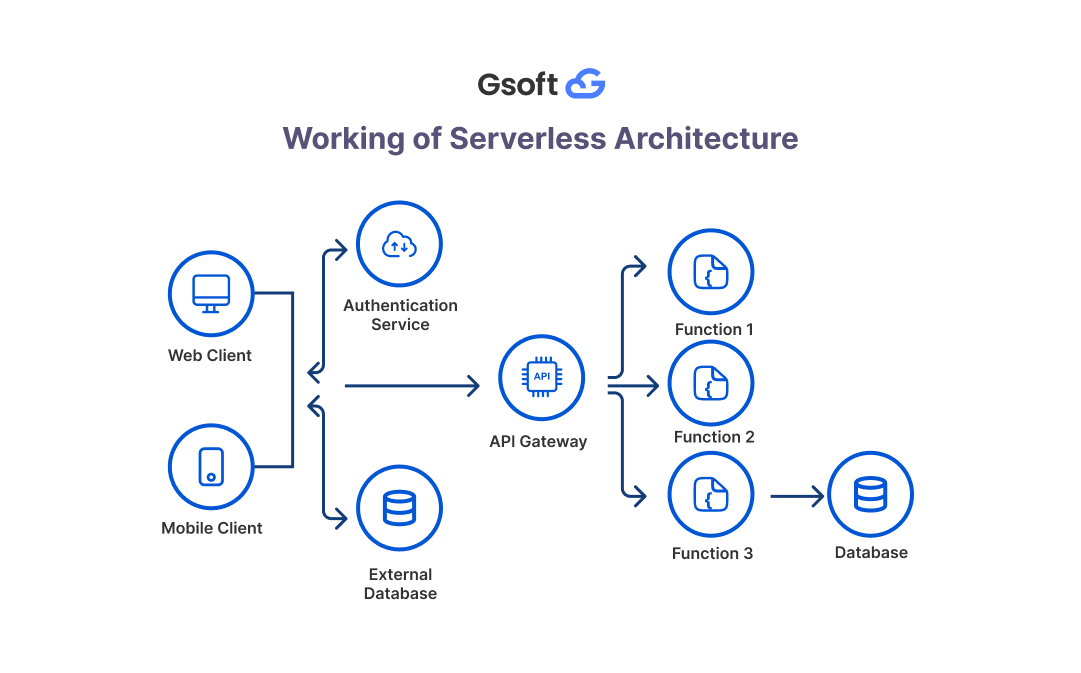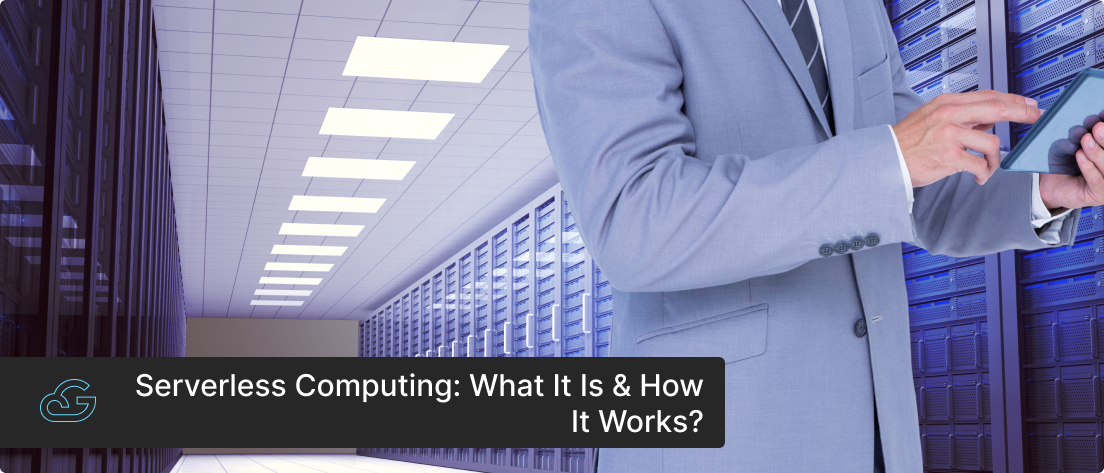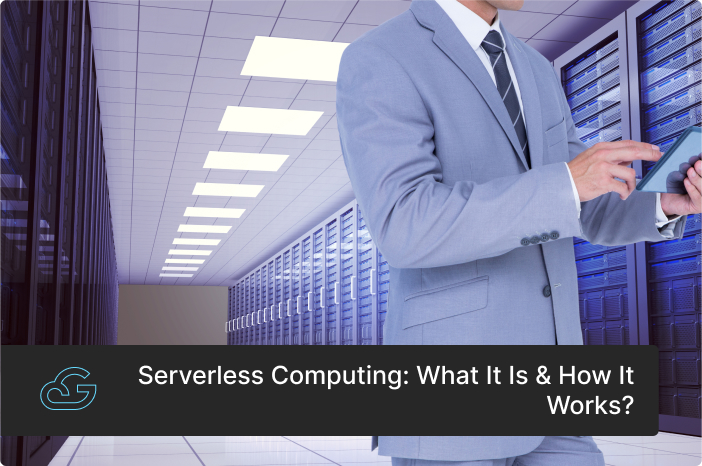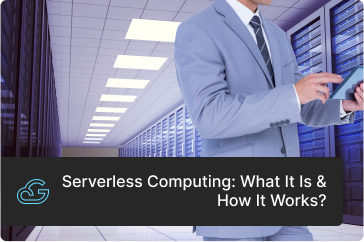Blogs / Cloud Native Development
Serverless Computing: What It Is & How It Works?
By
Sherin Job Varghese
Posted: December 5, 2023
• 7 Min 40 Sec
In today’s evolving world, businesses are always on the lookout for innovative ways to improve their operations and enhance their digital offerings. Serverless computing has emerged as a game-changing technology that enables organizations to optimize their application development process, reduce costs, and easily scale their operations.
The Power of Serverless Computing
According to reports, there has been an increase in the adoption of serverless computing. This cloud service model is experiencing a growth rate of 75%, making it one of the growing options available. Businesses worldwide are recognizing the advantages of using serverless architecture, which allows them to focus on their core strengths while leaving infrastructure management complexities to experts.
What is Serverless Computing?
- Serverless computing delivers backend services based on usage without requiring users to manage the underlying infrastructure.
- When utilizing a serverless provider, individuals and companies can develop and deploy code without the complexities of infrastructure management.
- Clients who obtain backend services from a serverless vendor are billed according to their actual computational usage, eliminating the need to pre-allocate and pay for a predetermined amount of bandwidth or a fixed number of servers.
- It's worth noting that, despite the name "serverless," physical servers are still employed in the background, but developers are shielded from having to interact with them directly.
You May Also Like: Benefits Of Using Serverless Computing
Key Components of Serverless Architecture
Serverless architecture is composed of several key components, each playing a critical role in enabling its functionality and achieving the benefits of serverless computing, including scalability, cost-effectiveness, and efficient resource management.
Understanding these components is essential for designing and implementing effective serverless solutions in various cloud environments.
-
Function as a Service (FaaS)
- Serverless architecture relies on FaaS to execute logic and allocate resources.
- Cloud providers like AWS, Azure, Google Cloud, and IBM offer FaaS services like AWS Lambda, Azure Functions, Google Cloud Functions, and IBM Cloud Functions.
- These functions interact with the backend database and respond quickly when triggered by user events.
-
The Client Interface
- The client interface is a crucial element in serverless design.
- It must be tailored to support short bursts of requests, stateless interactions, and flexible integrations.
- Whether dealing with high or low volume data transfers, the interface plays a pivotal role in ensuring seamless communication with the serverless components.
-
A Web Server on the Cloud
- Distinct from the backend database, the web server is where stateless interactions are initiated and processed.
- For instance, in the context of an online video content provider, user requests, scripts, and FaaS responses are hosted on the web server before being terminated due to the ephemeral nature of serverless.
- Meanwhile, the actual video content resides in the backend storage, ready to be fetched in response to user requests.
-
A Security Service
- Serverless applications commonly utilize token services and generate temporary user credentials to address security concerns.
- Additionally, integrated identity and access management services, such as AWS Cognito, offer Single Sign-On (SSO) and social network authentication options, enhancing security across the chosen cloud vendor.
-
Backend Database
- The backend database stores the information intended for user access, ranging from static content repositories to SQL databases and various media storage options.
- Developers often opt for Backend as a Service (BaaS) solutions to reduce maintenance efforts.
- Most cloud vendors offer BaaS solutions that seamlessly integrate with their respective FaaS offerings, simplifying database management.
-
API Gateway
- Serving as a vital link between components, the API gateway connects FaaS (component 1) and the client interface (component 2).
- When a user initiates an action, the API gateway relays the request to trigger an event through the FaaS service.
- This gateway can connect the client interface to multiple FaaS services, expanding the application's functional capabilities.
How Does Serverless Computing Work?

- Serverless computing, rooted in event-triggered code execution, closely relates to "Functions-as-a-Service" (FaaS) in the realm of event-driven cloud computing.
- FaaS automates server-side logic execution without user intervention, activated by diverse events, from HTTP requests to database queries.
- Serverless functions run in stateless containers, allocating resources only upon invocation, with no memory or data retention.
- Each request resets the application's state, necessitating resource provisioning from scratch.
- To adapt to this stateless approach, applications are typically designed as functions, often using microservices for scalability.
- While monolithic apps can be single functions, this is less common due to performance drawbacks, as a new compute container is created for each request.
Use Cases of Serverless Computing
Serverless architecture, a revolutionary approach to computing, excels in handling short-lived tasks and managing workloads characterized by sporadic or unpredictable traffic patterns. Its versatility and scalability make it an ideal choice for various use cases, such as:
-
Trigger-Based Tasks:
Serverless architecture shines when dealing with tasks triggered by user activities. Consider a user signing up on your website, which can initiate a sequence of events like database updates and welcome emails. You can seamlessly handle these backend processes with serverless functions, ensuring a smooth and responsive user experience.
-
Building RESTful APIs:
Harness the synergy of Amazon API Gateway and serverless functions to craft RESTful APIs that effortlessly scale to meet increasing demand. This combination offers a flexible, cost-effective solution for creating APIs that adapt dynamically to traffic fluctuations.
-
Asynchronous Processing:
Serverless functions excel at handling background tasks without disrupting your application's performance. Whether it's rendering product information or transcoding uploaded videos, serverless ensures these resource-intensive operations run efficiently behind the scenes, eliminating user-facing delays.
-
Security Checks:
Enhance your security posture with serverless by invoking functions to scan new instances for misconfigurations or vulnerabilities. Additionally, serverless functions provide a secure alternative for tasks like SSH verification and two-factor authentication, bolstering your system's defenses.
-
Continuous Integration (CI) and Continuous Delivery (CD):
Automate your CI/CD pipelines by integrating serverless architectures into your development workflow. Code commits can trigger functions to initiate builds, while pull requests can seamlessly initiate automated tests, streamlining your software delivery process.
Who Should Consider a Serverless Architecture?
Both business owners and developers should consider a serverless architecture for various reasons.
Business owners:
-
Lower Costs of Running a Server
- Serverless platforms, like AWS Lambda, charge for usage only when functions actively process events, eliminating costs associated with idle time.
- This cost-efficient approach reduces the overall expense of running a server.
- Businesses can avoid the need for redundant active services and complex disaster recovery planning.
-
Utilizing Specialized Services
- Serverless allows businesses to break down their applications into separate, independent logic components.
- This enables the utilization of specialized services for different tasks, resulting in cost savings.
- For instance, using services like AWS Cognito for client request authorization can shift costs from session-based to monthly active user-based, leading to economic advantages.
-
Client Access to Backend Resources
- Serverless architectures permit client applications to directly access resources that were traditionally considered part of the backend.
- This can simplify the system and reduce the need for gatekeeper components, which can be complex and costly to operate.
- The serverless approach can enhance efficiency and lower operational expenses.
Developers:
-
No Need to Run a Server 24/7
- Serverless eliminates the requirement to maintain servers continuously.
- Traditional servers often operate at low resource utilization rates, but serverless platforms optimize resource usage by executing code only when needed.
- This approach allows for cost savings, as developers are charged only for their functions' running time.
- Additionally, automatic scaling ensures that more functions can be run to handle increased requests.
-
No Need to Figure Out Infrastructure Pitfalls
- Serverless simplifies the development process by using simple functions as building blocks.
- Developers can focus on writing code and shipping it without delving into complex infrastructure considerations.
- While there is still a need to address issues like communication between functions and client interactions, the overall infrastructure complexity is reduced.
-
Focus on Core Product
- The modularity of serverless architectures enables a product-oriented approach to feature development.
- Different developers or teams can easily manage specific features without the constraints of deploying an entire server.
- However, effective communication between teams is essential to prevent conflicts.
Elevate Your Serverless Journey With Gsoft's Expertise
As a prominent cloud computing service provider, Gsoft Cloud Consulting specializes in harnessing the potential of serverless architecture. With a team of experts possessing extensive cloud technology knowledge, Gsoft delivers customized solutions aligned with the client's business goals. Their vendor-agnostic approach ensures clients leverage the best cloud platforms such as AWS and Azure, while optimizing costs and driving growth.
Ready to harness the power of Serverless Computing for your business? Discover Gsoft cloud consulting capabilities today.
FAQs about Serverless Computing
Q:
What are the core things present in the Serverless Stack?
- The core components of a serverless stack are:
- Function as a Service (FaaS): It is the foundation of serverless computing. FaaS runs code without server provisioning or management. Events trigger code execution. Then it ends.
- Event-driven architecture: Serverless applications are triggered by HTTP requests, database changes, or file uploads. This lets you develop scalable, resilient apps that respond fast to events.
- Storage: Serverless apps often store data in cloud storage. This can be object, block, or file storage.
- Networking: Cloud networking links serverless apps to other services and resources. API gateways, load balancers, and VPNs enable this.
- Logging and monitoring: Monitor serverless apps for appropriate operation and problem-solving. You can log and monitor using cloud services or your own infrastructure.
Q:
What problems does serverless solve?
Serverless computing addresses several challenges, including eliminating the need for server management, optimizing resource utilization, auto-scaling to handle varying workloads, and reducing infrastructure costs. It also simplifies deployment and allows developers to focus on coding rather than infrastructure management.
Q:
When should I use a serverless architecture?
- The key situations where serverless architecture can offer significant advantages include:
- High-latency background tasks such as multimedia or data processing.
- Client-heavy applications where the majority of the logic can be offloaded to the client.
- Applications experiencing unpredictable fluctuations in server load.
- Rapidly growing and dynamically changing applications that require instant scaling and frequent feature updates.
Q:
What are some real-time examples of serverless computing?
- Coca-Cola's adoption of serverless technology revolutionized its vending machine experience. In 2016, Coca-Cola introduced the Freestyle vending machines, leveraging serverless and cloud-based architecture. These smart machines enabled customers to order drinks, make payments online, receive their orders, and receive confirmation messages on their mobile phones.
- Netflix, a pioneer in serverless computing since 2017, demonstrates the scalability and efficiency of this approach. Netflix's Dynamic Scripting Platform relies on serverless architecture for handling thousands of daily modifications and media deliveries.
Q:
Is serverless computing good for startups?
Yes, serverless computing is advantageous for startups as it offers cost-effective scalability. Startups can benefit from reduced infrastructure costs and focus on innovation, making it an attractive choice for resource-constrained businesses.
Q:
Do you need a backend for serverless?
Serverless applications can use Backend as a Service (BaaS) to abstract backend logic, but whether you need a backend depends on your application's requirements. Some serverless applications may still require backend components for specific functionalities.
Bottom Line
Serverless computing has become a game changer, for businesses looking to improve their operations. By adopting serverless architecture organizations can concentrate on innovation, scalability and cost efficiency while entrusting infrastructure management to experts. As technology advances, serverless computing is expected to influence the future of application development.
Reach out to us today to explore the limitless possibilities of serverless computing!


Get Know More About Our Services and Products
Reach to us if you have any queries on any of our products or Services.











